Jaina art is an important element of Indian art. This was realized at an early date as is seen for example from Burgess's impressive study of the Jaina temples of Shatrunjaya, published as early as 1869. A number of substantial studies on Jaina art have been published since then, but much remains to be done until Jaina art is as well-known as Hindu and Buddhist art.
One facet of Jaina art is painting, generally known as miniature painting because most of the pictures are rendered in small size[1]. Jaina miniature painting sprung up in Western India, that is to say in Gujarat and the adjacent areas of Rajasthan[2]. Schools of miniature painting which arose in the South (Karnataka) and in the North (Delhi area) are less important. The title of our article is identical with the title of a book by Moti Chandra published in 1949 in Ahmedabad which became a standard work. The title (2004) is thus an indirect homage to Moti Chandra.
Although most of the paintings from Western India are kept in Indian collections (bhandars[3] and museums), some have found their way into foreign countries. Visitors of museums in Europe and America will mostly see paintings from the Kalpasutra because no Jaina work has been illustrated so often as the Kalpasutra. This should be mentioned right at the beginning. In fact, six out of twelve paintings to be published and discussed below are taken from that work.
The reader is probably not surprised to find before our series of paintings illustrations of two Jina bronzes, one Jina seated and one Jina standing, both Jinas naked, both shown en face. These two Jinas represent fundamental types. They are the main objects of worship for all Jainas who worship Jina images (= Tirthankara images). There are also Jainas who do not worship images, but even they hold Jina images (our two types) in high esteem[4]. The seated Jina is almost identical with the seated Buddha, whereas the standing Jina is confined to Jaina iconography.
We show in seven subsequent cases always two connected objects. It is hoped that this arrangement in pairs will give additional emphasis to each individual case.
Figs.1-2. Jina images are found in India from the 1st/2nd centuries A.D. to the present day. There are thousands of them, differing in size and quality and distributed over most parts of the subcontinent. Our two bronze images from Karnataka[5]are not among the earliest Jina images but they are pieces of considerable antiquity and of rare artistic quality. The identity of the two Jinas is unknown (problem of identification, see below).
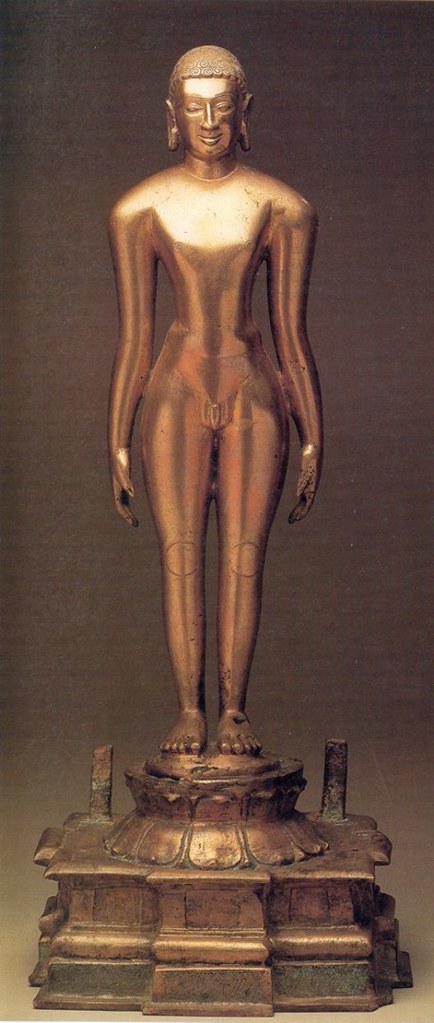 Bronze Jina (Karnataka)
Bronze Jina (Karnataka)
Fig.1. Bronze Jina (Karnataka)
The standing image measures 61 cm in height. It stands on a lotus plinth which is in turn placed on a rectangular pedestal on which are two upright tenons for fixing a now missing halo. B.V.Shetti observes: "The long arms dangling on either side, the slightly drooping and finely rounded shoulders, the sublime serene face, the meditative eyes, the faint smile on the lips, the elongated ear-lobes and the curly hair-locks on the head add beauty to this otherwise unadorned nude figure." The inscription all round the pedestal praises Somadevi, the sister of a king who ruled in Karnataka from A.D.961 to 974
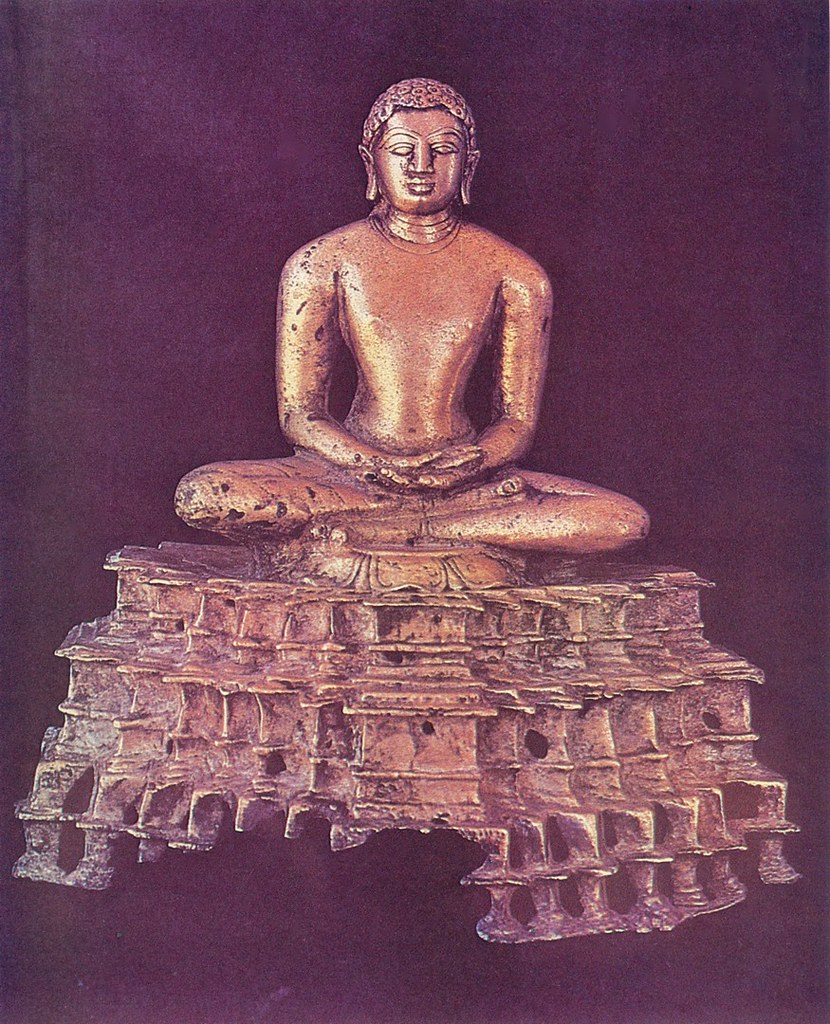 Bronze Jina (Karnataka)
Bronze Jina (Karnataka)Fig.2. Bronze Jina (Karnataka)
The seated Jina image can be dated to the 10th-11th centuries. It has likewise been studied by B.V.Shetti. The inscription says that a certain lay-brother, Malabbe by name, presented the image to a Jaina establishment. "The Jina is seated with hands in a meditative gesture. The hair is arranged in small curls, and there is the trivali (triple fold) on the neck. The chest, shoulders and arms are powerfully rendered. The pedestal shows articulation that becomes common in the basement mouldings of Jain temples of a later period."
Figs.3-8[6]. We shall now study our miniature paintings, including six Kalpasutra miniatures. We must also mention the literary Kalpasutra tradition. The Kalpasutra contains inter alia the Biography of Mahavira ("Great Hero"), the founder of Jainism. This biography includes numerous episodes, starting with the conception and birth of M., including his renunciation and his proclamation of the doctrine, and ending with M.'s final emancipation (compare the Nirvana of the Buddha). The episodes are depicted in the Kalpasutra manuscripts and the miniatures of different Kalpasutra manuscripts show identical episodes in a similar manner. According to the Jaina tradition, there were 24 Jinas or Tirthankaras (Mahavira being the last), all preaching the Jaina doctrine, but all living in different periods of the mythological panorama. Only Mahavira (no.24) and his immediate predecessor (no.23: Parshva) were historical. The biographies of nos.1-23 are also included in the Kalpasutra, some short, some only tabular. Other Jaina works describe the biographies of all the 24 Jinas in some length, the narrative cycle being more or less the same as in the case of Mahavira (but with occasional additions and omissions). -- The Kalpasutra belongs to the Jaina Canon, a vast body of literature dating back to the centuries before and after our era[7]. The Kalpasutra itself can be dated into the 2nd-3rd centuries A.D. The Jina biographies are its main subject but not its only subject.
Jaina miniature painting in Western India starts in the 11th and ends in the 16th century. The greater part of the material belongs to the 15th century (our figs.3-8). In Western Indian miniature painting, the Jina is always shown as seated. Our figs.3-6 are taken from a single Kalpasutra manuscript dated 1411 A.D.
Figs.3-4. Our first two miniatures (figs.3-4) portray the Jina as known in broad lines from Jaina sculptures. A special feature of the Western Indian miniatures is the so-called protruding eye of figures appearing in profile. This protruding eye is unexplained, and several illustrations have been found in other parts of India. Good examples (clarity slightly limited) are our figs.5-6.
 Seated Jina (paper ms.)
Seated Jina (paper ms.)
Fig.3. Seated Jina (paper ms.)
Fig.3 shows a Jina miniature in a Kalpasutra manuscript. The first question might concern the identity of the Jina, the main figure -- which of the 24 Jinas is shown? The identity of a Jina (in painting or in sculpture) is normally indicated by a motif ("symbol") immediately below the Jina. However more often than not, the symbol (in most cases an animal) is missing or unclear. In the present case it is apparently a minute drawing of a bull, and this would identify the Jina as Rsabha, the first in the series of the 24 Jinas. -- There are many other motifs in this miniature, all meant to symbolize the spiritual grandeur of the Jina as the main figure. Some of the small human figures are heavenly dancers and musicians. The Jina himself is richly decorated and provided with a tiara, features which are not found on earlier Jina images. He is also not really naked, a matter which requires explanation (figs.3-4)[8]. A fruit, barely visible, lies on his hands, and a mark or tilak is seen on his forehead. Both features belong to the iconography of the Jina. The head of the Jina is encircled by a vegetable motif (two curved green stalks with buds). This is a very old feature, deriving ultimately from a sacred tree and clearer in Jaina sculpture. The Jina is seated on a lion throne, scarcely visible behind the heavy garland flowing down from his shoulders. The basic colour combination is white/gold on a red background. The whole miniature reflects more or less the old artistic traditions of Jina sculpture. The motifs surrounding the Jina are called "girdle" (parikara). Some girdle elements are typical of the Jina, some are also found elsewhere (with gods and goddesses of the pan-Indian pantheon as main figures).
 Emancipated Jina: Mahavira (paper ms.)
Emancipated Jina: Mahavira (paper ms.)
Fig.4. Emancipated Jina: Mahavira (paper ms.)
Fig.4 lacks the host of small figures, but the nuclear Jina of fig.4 resembles that of fig.3. The symbol below the Jina is a lion (more distinct than the bull of fig.3), and the Jina is thus Mahavira. There are two major differences in contrast to fig.3. Below Mahavira we see a white crescent, symbol of the place of salvation. The Jainas have very detailed views of the universe and of the region of salvation at the top of the universe (by contrast, the nirvana of the Buddhists is beyond all human description). Miniatures portraying the emancipated Jina in this way are not rare. The second difference consists in the two white discs flanking Mahavira at head height. They are a peculiarity of the present miniature and cannot be explained by us.
Figs.5-6. The next miniature (fig.5) shows the mother of a Jina after conception.
 Mother of the Jina: The fourteen dreams (paper ms.)
Mother of the Jina: The fourteen dreams (paper ms.)
Fig.5. Mother of the Jina: The fourteen dreams (paper ms.)
The upper half of the picture is occupied by the fourteen lucky dreams which the mother of a Jina sees and which predict the birth of a Jina: elephant, bull, lion, goddess of fortune, two wreaths, a banner fixed to a golden staff, a vessel filled with water and lotuses ("vase of plenty"), a lotus-pond, an ocean (segment of a ring-shaped ocean encircling our world), a flying heavenly palace, a heap of jewels, a fire, moon and sun (both in the lower field). The dreams are later on interpreted by sooth-sayers (fig.7).
The dreaming queen is resting on a typical Indian bed. A pink blanket to be imagined below the mattress is raised on the farther side of the bed in a peculiar manner (viewed as it were "en face"). The queen has her left leg stretched and her right leg bent. She wears a green blouse (early choli) and a blue skirt (early ghaghri), the latter with a heart-like end (cloth gathered between the legs). In other miniatures, the portion with the "heart-like end" is shown from the front as the figure is standing or seated. Most characteristic is the odhni, a head-scarf (not very clear, but visible), formed here and elsewhere by one piece of cloth with two ends standing out stiffly from the body. Cover and pattern of the odhni are identical with those of the blanket. A sort of cushion in the right arm of the queen looks as if it were meant to receive one day the baby Jina. Below the royal mother we notice the standard objects: two bowls with betel, a spittoon and a carafe filled with water.
 Mother of the Jina with the new-born child (paper ms.)
Mother of the Jina with the new-born child (paper ms.)
Fig.6. Mother of the Jina with the new-born child (paper ms.)
Fig.6 shows the queen with the new-born child. The child is shown against a specific blue background, an artistic device also found elsewhere. The rendering of the queen and the bedding is similar to that of fig.5, but a pink blanket with tiny rosettes "behind" the queen is conspicuous and adds to the profusion of textile elements. Separate objects are a mirror (in the centre of the balustrade at the top), a vessel hanging down from the ceiling and the three familiar objects below the bed (stand with betel-leaves, carafe, spittoon).
Figs.7-8. The next two miniatures belong to a fine manuscript which mainly uses the three colours red, gold and blue. There are also other manuscripts of the fiftenth century which use this particular colour scheme but they are mostly of a lesser standard.
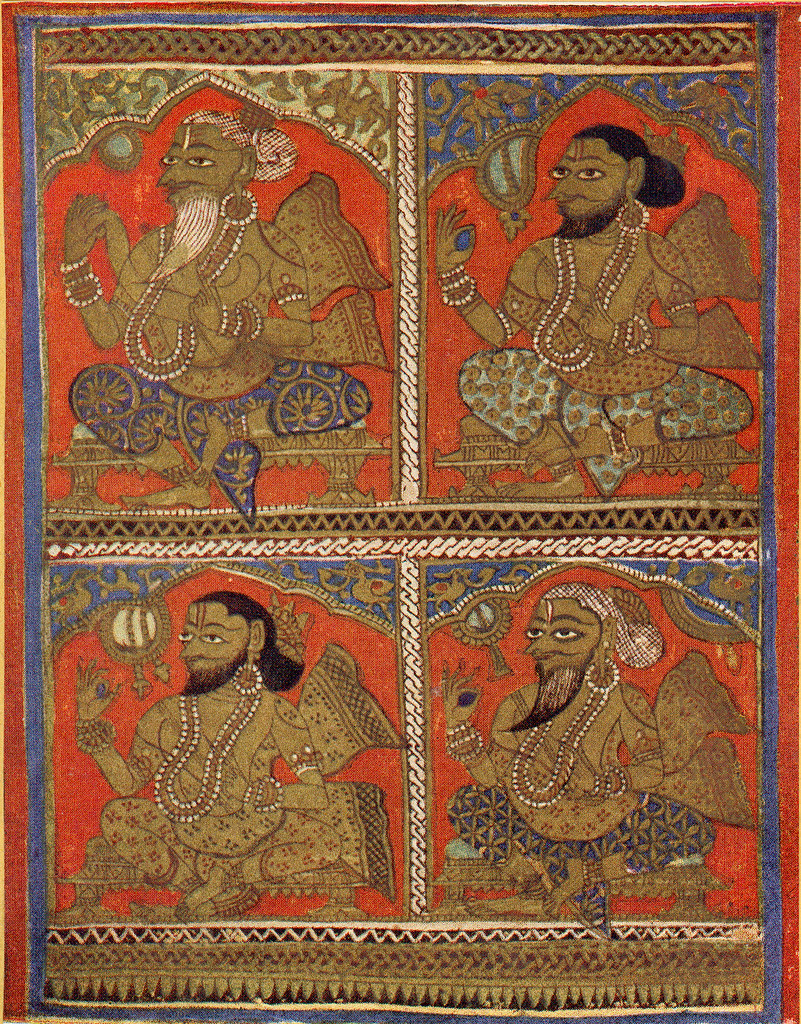 The four Sooth-Sayers (paper ms.)
The four Sooth-Sayers (paper ms.)
Fig.7. The four Sooth-Sayers (paper ms.)
The first picture shows the four sooth-sayers who interprete the dreams of the royal mother of the Jina (see above) as told to them by the royal father. Having heard the explanation of the sooth-sayers, the father imparts it to the mother. All four figures display the scarf (dupatta) wound around the waist, the two ends standing out from the body. The artist has introduced variety: different colours of the hair, of the beards, of the dhoti. Further decorative efforts (border etc.) are likewise worthy of note (compare the next figure).
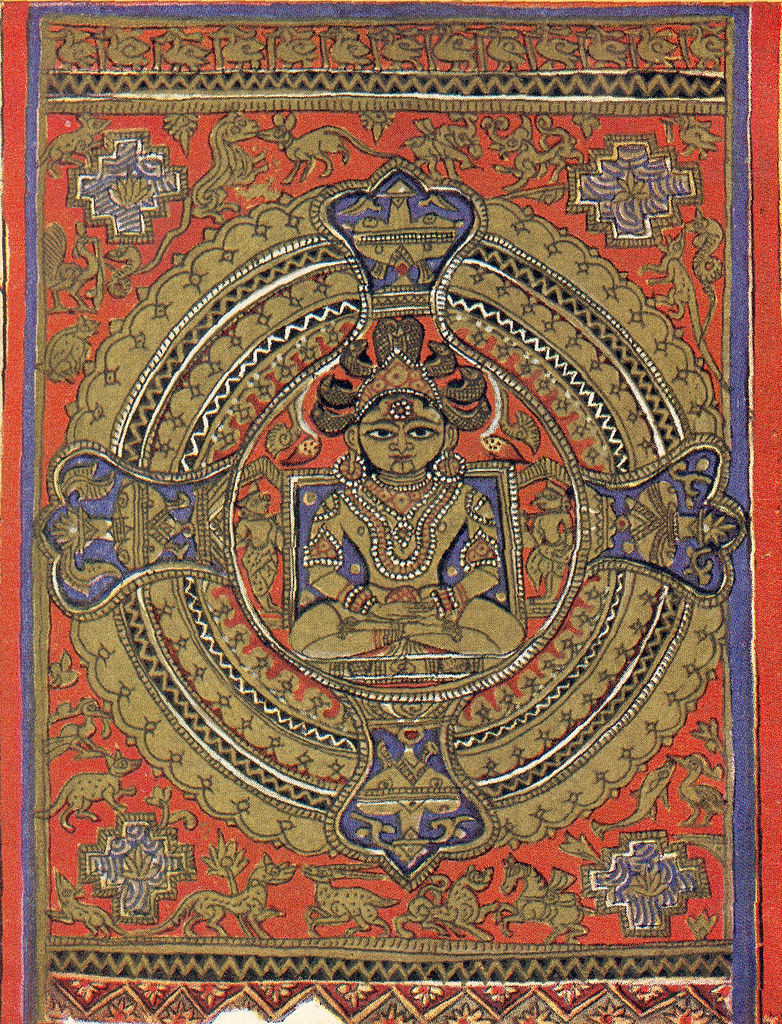 The Samavasarana (paper ms.)
The Samavasarana (paper ms.)
Fig.8. The Samavasarana (paper ms.)
[Samavasarana Painting]
Fig.8 shows a so-called samavasarana, a mythological structure which is closely connected with the Jina legend, i.e. with the lives of the twenty-four Jinas. All the Jinas delivered their sermons in such a construction. It is an open arena or amphitheatre, the round area in the centre surrounded by three circular walls. The Jina is seated in the centre, and quadrupled in a way so that he is seen from all four sides. The assembly of listeners, human beings and gods, is seated in the central area. Our picture is highly stylized, the four entrance gates being rendered as "vases of plenty" etc. etc. The Jina shown is Parshva. He can be recognized by his seven snake hoods, a peculiarity which is explained in a legend[9]. The corner areas show a complex motif which is typical of the samavasarana miniatures of Western India: four tanks (with stepped outline) surrounded by numerous animals. The animals are mostly shown in pairs, one a vegetarian and the other a beast of prey. All beings are thus shown as living harmoniously together under the peaceful influence of the sermon of the Jina.
Figs.9-10[10]portray two worshippers, a bearded layman and a laywoman, both seated with their legs crossed. Their hands are placed together, performing an act of worship (anjali). The cloth between their hands is evidently a utensil linked with worship and known from other contexts. A small boy is represented behind the male figure and a basket behind the female figure.
 Layman in worshipping posture (palm-leaf ms.)
Layman in worshipping posture (palm-leaf ms.)
Fig.9. Layman in worshipping posture (palm-leaf ms.)
 Laywoman in worshipping posture (same ms. as fig.9);
Laywoman in worshipping posture (same ms. as fig.9);
Fig.10. Laywoman in worshipping posture (same ms. as fig.9)
The two adorants stand out clearly against the red background. The rendering is balanced when compared with the paintings of the paper period. The manuscript supplies perhaps some information about the two figures. It is dated 1241 A.D. and written on palm-leaves. It is thus much older than the manuscripts of the six preceding figures. Paper was introduced round about 1500 A.D.
Figs.11-12[11]Before the introduction of paper, all manuscripts were written on palm-leaves, and these folios were extremely long (e.g. 36" by 3"). The Jainas introduced wooden boards, patlis, to keep the bundle of leaves together. Apart from that there were holes in the leaves (folios) through which cords were led for the same purpose. Quite a few of these patlis were decorated with paintings, partly of a narrative character, partly ornamental (figs.11-12).
 Patli: preparations for Nemi's marriage
Patli: preparations for Nemi's marriage
Fig.11. patli: preparations for Nemi's marriage
Our first figure shows a section of the biography of Nemi, the 23rd Jina. We have to remember that all Jinas were married, Nemi being the only exception. Our figure represents Nemi (his colour being blue) on a twowheeled chariot with the charioteer before him, advancing to the house of his prospective bride. His name ("Nemi") is written above him. When the vehicle reaches its destination, Nemi suddenly sees a large number of game kept in an enclosure and waiting to be slaughtered. The meat is to be served to the guests attending the marriage. Now, every student of Jainism knows that in this religion meat eating is a great offence, as it violates the law of ahimsa (non-violence). In fact, Nemi was shocked, forsook the idea of marriage and renounced the world. His intended, Rajimati, was sad beyond measure when she heard of Nemi's decision. She thereupon adopted the same course. Our painting shows the helpless animals in the enclosure, and by way of a pictogram the marriage. The marriage pictogram consists of two rows of superimposed pots, forming two posts which are held together by a green garland at the top. This may stand for a gate (for the reception of the bridegroom and his party in the house of the bride) or for a temporary structure (naturally with four posts) for the marriage ceremony in the house of the bride. The Nemi story is thus narrated in juxtaposed motifs or pictograms. The body-modelling (Nemi and the two horses) is an indication of an early age (11th cemtury A.D.?). The protruding eye is visible but not very prominent.
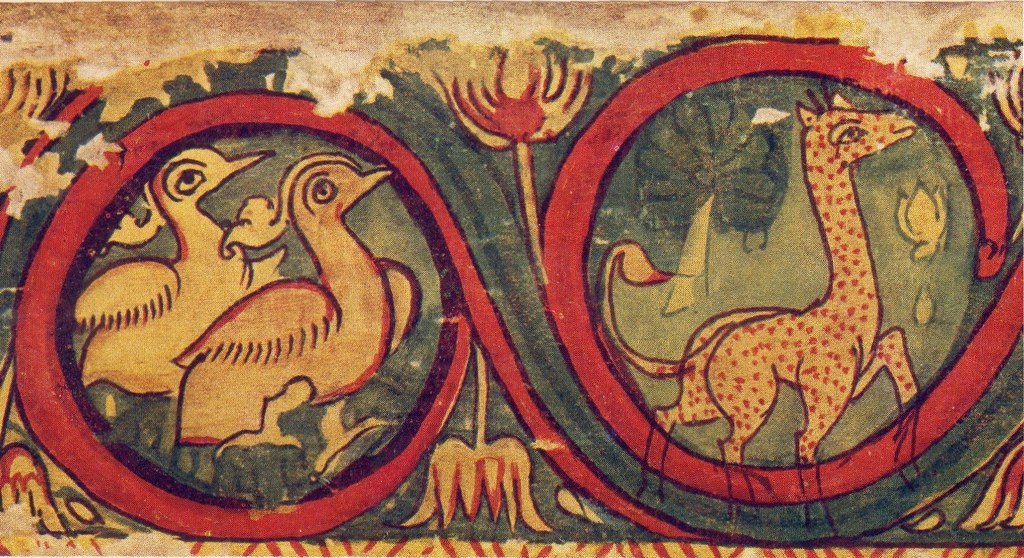 Patli: two roundels of a creeper
Patli: two roundels of a creeper
Fig.12. patli: two roundels of a creeper
The next fig. shows a decorative patli painting. In the roundels of a running creeper we see a pair of birds (geese) and a giraffe. A giraffe is also depicted on a slab attached to the plinth of the sun-temple at Konarka (Orissa)[12]. It has been observed that political relations and trade relations might have brought rare and exotic animals to interested (and wealthy) individuals. A present of a zebra (then unknown in the imperial court) was made to the Mughal Emperor Jahangir (ruled 1605-1627).
Figs.13-14.[13] Miniatures and even patli-paintings were always of limited size. The ground for large-size paintings was cloth. The cloth painting to be discussed by us is dated 1433 A.D. and measures 30 feet by 12 inches. It includes seven separate paintings. We have selected two "sections" from the third paiting. The third paiting is prima facie a narrative sequence, but (judging from our two "sections") it is in the first place an assemblage of typical scenes which are not properly connected. The total painting describes a pilgrimage to a Jaina temple on a hill, the relevant hill being apparently Shatrunjaya (Kathiavar, Gujarat State). Below we describe the main features. The Jinas depicted in the two "sections" are portrayed in different colours; two Jinas are Parshvas (colour: blue), the others cannot be identified: colour calculated to be gold. Gold is (according to the texts) the colour of the majority of Jinas. Moreover, Parshva is always depicted with seven snake-hoods above his head. This peculiarity is connected with his legend (9). The round ramparts in both "sections" are reminiscent of the samavasarana concept.
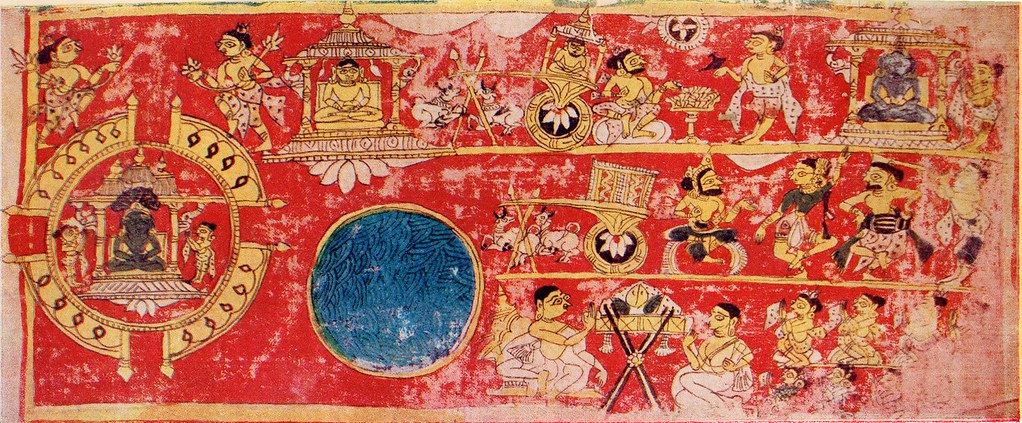 Painting on cloth. "Section" of the third painting depicting a pilgrimage
Painting on cloth. "Section" of the third painting depicting a pilgrimage
Fig.13. Painting on cloth. "Section" of the third painting depicting a pilgrimage
Fig.13 reveals in its upper panel pious Jaina laymen ascending a hill. The lower panel displays two Jina shrines in a round rampart to the extreme left. To the right follows a cart with the bullocks unyoked. Below the cart is seen a preaching monk with the familiar sthapana, or symbol of the teacher, before him. The sthapana is a stand consisting of crossed sticks on which a sacred text or conch shells were placed. To the right of the rampart is a round tank with typical stylization of the water.
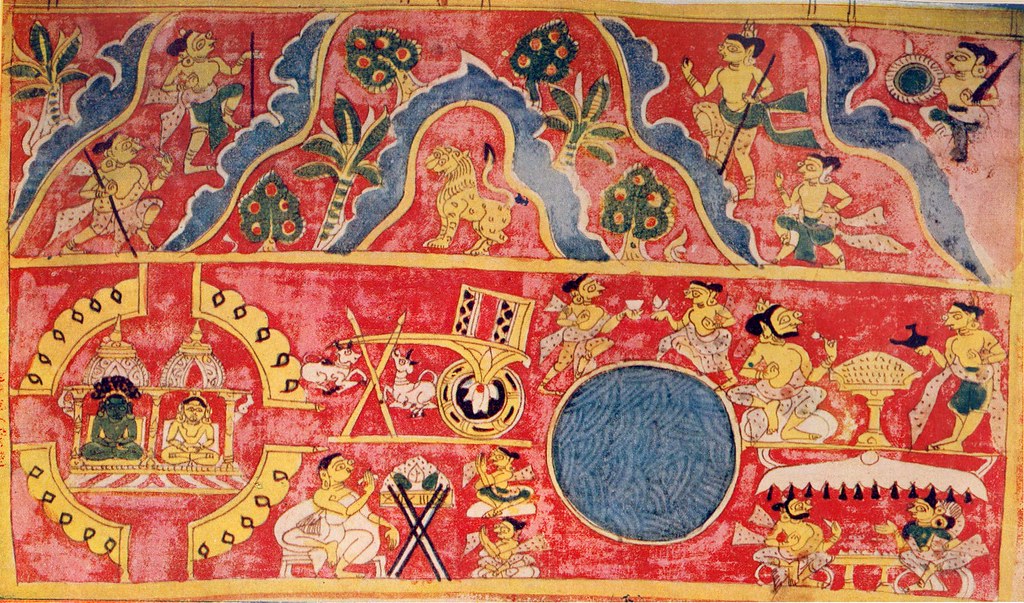 Painting on cloth. Another "Section" of the third painting (fig.13)
Painting on cloth. Another "Section" of the third painting (fig.13)
Fig.14. Painting on cloth. Another "Section" of the third painting (fig.13)
Fig.14 has much in common with fig.13. There is a Jina shrine in a round rampart, and there is a round tank (same combination in both pictures). A monk with sthapana is instructing another monk as well as a group of lay-followers (all third line). We see again two carts with unyoked bullocks, but one of the carts carries a Jina image and serves perhaps as a procession car (first line and second line). There are two Jina shrines (first line).
Although the complete paiting is not available, one can speculate that the two "sections" show the pilgrims leaving their carts, listening to spiritual teachers, and climbing finally up the Shatrunjaya hill. The style is simple, even by the standards of the time, but the paintings are interesting from the point of view of the history of the Jaina church.
In art, Jinas were originally always naked, while monks generally carried a piece of cloth which enabled them to cover their private parts. Since the split the groups were clearly separated (supra), and we have the following situation in art. Digambara Jinas are naked, and Digambara monks (now a separate category in art) are likewise naked. Shvetambara Jinas are clearly clothed (dhoti) when standing, and depicted with their private parts invisible when seated. After some time, a piece of cloth was introduced by the Shvetambaras, visible as a fan-shaped feature between the legs. But this was only a sectarian mark, demonstrating that the relevant Jina image belonged to the Shvetambara community (our figs.3-4: cloth, forming a triangle). Shvetambara monks (and, naturally, nuns) were also shown as completely clothed.
Demographically, Digambara monks and lay-followers are now a minority in the Jaina community, Shvetambaras forming the majority. In the past the situation was different.
 Prof. Dr. Klaus Bruhn
Prof. Dr. Klaus Bruhn